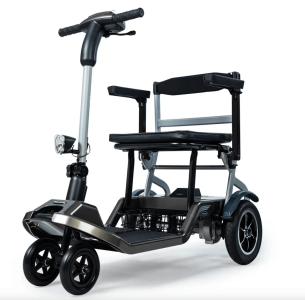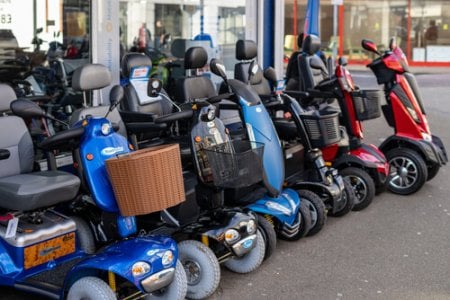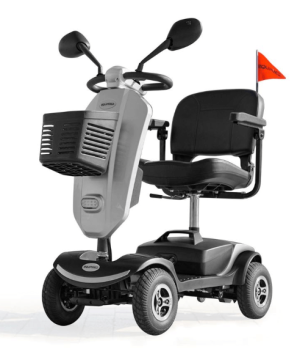Tech Talk with Dr Al: Mobility Scooters – No Hoons Here!
- Replies 21
Note from the Editor:
This article was kindly written for the SDC by member Alan G, ‘The Tech Guy’.
As we get older, it appears to be inevitable that our mobility becomes progressively more reduced. I’ve had ‘repaired’ meniscus cartilages in both knees – they simply cut off the split-away bit when they don’t consider you’re young enough for decent blood flow in the cartilage. Of course, this means that I’ll get increasing pain in both knees as I get older, which, so far, I’ve learnt to put up with. There are many of us in the same boat – we’ll probably have to use a stick at some stage, then a walker, then a mobility scooter in the fullness of time.
I’ve bought myself a little time by managing (with my lovely wife’s help) to lose over 25kg. This relieves the pressure on my knees, so they should last a bit longer. The other assistive method was to start using arch supports about 20 years ago when my feet developed plantar fasciitis. After a couple of months of use, the pain from that disappeared and has never returned – and the arch supports only cost about $10 a pair online. I’ve no doubt, though, that in the fullness of time, I’ll need a mobility scooter.
Types of Mobility Scooters
Mobility scooters, sometimes called ‘gophers’, differ from electric wheelchairs in that the former generally have a much greater range and are designed to be used out of the home. Of course, they are less manoeuvrable than electric wheelchairs.
Mobility scooters are a really good idea, and they can certainly improve the quality of life for a senior, but what type should you buy? They range from relatively cheap fold-up electric scooters to almost fully-fledged electric vehicles for road use.
Folding Electric Mobility Scooters:
When you read the description, it does appear that a ‘folding’ mobility scooter does not necessarily mean it’s a one-person job to lift it. Also, bear in mind that a ‘light’ folding scooter may not be that comfortable to ride over long distances. If you buy one of these items, you will obviously need the strength to fold it up, assuming you bought it to slip into the boot of your car for shopping. The weight varies considerably depending on the quality of the scooter and the size of the rechargeable battery.
The Equipmed Electric Mobility Scoote, sold by Bunnings for $1079, has a range of about 15km and can travel at 8km/hour. The average walking speed at our age is roughly 3.5km/hour.
It’s really not a one-person job to lift it into and out of your car as it weighs around 50kg. Surprisingly, it uses a lead-acid battery.
The eFOLDi Lite Folding Portable Scooter from Bee Free Mobility is one of the lightest, at 15kg without its lithium rechargeable battery and 17kg with it – not too heavy for one person – and has about the same range, but costs a lot more, at $2500.
Both these portable scooters have solid tyres, so you won’t need to worry about punctures.
Weighing about the same (15kg with the lithium battery) is the Travelscoot Fold-Up Mobility Scooter, but the cost is around $4800.
Somewhere in this range, there is a fairly light portable mobility scooter at a price that would make it economically viable. You’d need a reasonable quality scooter – I couldn’t recommend a machine from AliExpress unfortunately, despite the excellent prices, not necessarily because of the quality, but the postage costs about as much as their scooters! You are far better off in general, to buy locally so that you’re covered for any problems you might have.
The Equipmed Ultra-Lightweight Folding Electric Mobility Scooter sold by Woolworths Online at $1574 seems to tick all the boxes though. It's fairly lightweight, at 19kg including its lithium battery. I was able to reduce the price by nearly $300 by checking other online stores.

Road-worthy Mobility Scooters:
Three or four-wheeler mobility scooters are available, and there are pros and cons for both. 3-wheeler machines give you more legroom and need less space to manoeuvre, and they are marginally cheaper as well. A 4-wheeler is generally more comfortable and has better stability over longer distances, especially if you opt for larger wheels than the non-inflation type.
When choosing a machine, you will need to consider legroom, comfort, weight and maximum range. It is a very good idea, if possible, to take one on a test run before committing yourself to buy.
My rule about making any purchase – not necessarily for mobility scooters alone – is to decide on the model/brand and then try to find the best price for it. It seems a simple mantra, but when you’re faced with a high-pressure salesman and a shiny new ‘thing’, it’s easy to let common sense go out of the window. You may decide to rent a mobility scooter from the Red Cross, for instance – they have an impressive range. One good manufacturer springs to mind: ‘Pride’. They make a good and reliable product, but there are many others, such as Invacare and Shoprider.
Where can you use a motorised mobility scooter?
When using a motorised mobility scooter outside of the home, for example, on a footpath, the person using the device is a pedestrian under the Queensland Road rules. To use a personal motorised mobility scooter on a footpath or road in Queensland (check the rules for your state/territory to be sure), you will need to register it. This is free, and you receive a number plate for the machine.
In Queensland, if you are travelling along the road, in the absence of a footpath, you must travel facing the on-coming traffic if possible, and your speed cannot exceed 10km/hr. There are restrictions on the weight of the machine, but you are allowed to have two people on the scooter. Although it is OK to use bicycle paths, it seems that it is not recommended.
Recommendations:
You need to be comfortable, so I’d make comfort a high priority. If you travel to the shops a few times a week, check the battery range. You’ll also need to insure the machine in case of accidents, theft or vandalism. Has it got any protection from rain? What about shopping storage? Does it have a reverse gear? Does the seat swivel or armrests raise for easy mount/dismount? Is the steering column adjustable? How long does it take to charge the battery? There are so many makes and types from small foldable to extra heavy duty, it is very dependent on your personal preference.
Good luck!
About the author: Having spent three years living in Australia in his youth, Alan returned to Australia in 1969 with his wife and young child. Holding a Bachelor of Engineering degree and a Doctor of Science Education degree, Alan has experience in flight simulations, Einsteinian physics, and inventing an ‘eye blink’ device that allows cerebral palsy patients to communicate. He even took a turn at acting, starring in a TV advert and landing supporting and lead roles in his local dramatic society plays. His short stories have been published in WA’s The Gingin Buzz for ten years, and his novel The Magic Hourglass is a work in progress. He and his wife have a lovely life in Brisbane and regularly visit their two children in Sydney’s West. You can read Alan’s full-length bio here.
From the Editor:
If you use a mobility scooter, we would love to hear from you in the comments below!
We were only able to create this content because of the financial support of SDC Rewards members. If you'd like to see more of this (and a lot fewer ads!), please consider supporting us and signing up for SDC Rewards today—it starts at just $5.99 per month.
This article was kindly written for the SDC by member Alan G, ‘The Tech Guy’.
As we get older, it appears to be inevitable that our mobility becomes progressively more reduced. I’ve had ‘repaired’ meniscus cartilages in both knees – they simply cut off the split-away bit when they don’t consider you’re young enough for decent blood flow in the cartilage. Of course, this means that I’ll get increasing pain in both knees as I get older, which, so far, I’ve learnt to put up with. There are many of us in the same boat – we’ll probably have to use a stick at some stage, then a walker, then a mobility scooter in the fullness of time.
I’ve bought myself a little time by managing (with my lovely wife’s help) to lose over 25kg. This relieves the pressure on my knees, so they should last a bit longer. The other assistive method was to start using arch supports about 20 years ago when my feet developed plantar fasciitis. After a couple of months of use, the pain from that disappeared and has never returned – and the arch supports only cost about $10 a pair online. I’ve no doubt, though, that in the fullness of time, I’ll need a mobility scooter.
Types of Mobility Scooters
Mobility scooters, sometimes called ‘gophers’, differ from electric wheelchairs in that the former generally have a much greater range and are designed to be used out of the home. Of course, they are less manoeuvrable than electric wheelchairs.
Mobility scooters are a really good idea, and they can certainly improve the quality of life for a senior, but what type should you buy? They range from relatively cheap fold-up electric scooters to almost fully-fledged electric vehicles for road use.
Folding Electric Mobility Scooters:
When you read the description, it does appear that a ‘folding’ mobility scooter does not necessarily mean it’s a one-person job to lift it. Also, bear in mind that a ‘light’ folding scooter may not be that comfortable to ride over long distances. If you buy one of these items, you will obviously need the strength to fold it up, assuming you bought it to slip into the boot of your car for shopping. The weight varies considerably depending on the quality of the scooter and the size of the rechargeable battery.
The Equipmed Electric Mobility Scoote, sold by Bunnings for $1079, has a range of about 15km and can travel at 8km/hour. The average walking speed at our age is roughly 3.5km/hour.
It’s really not a one-person job to lift it into and out of your car as it weighs around 50kg. Surprisingly, it uses a lead-acid battery.
The eFOLDi Lite Folding Portable Scooter from Bee Free Mobility is one of the lightest, at 15kg without its lithium rechargeable battery and 17kg with it – not too heavy for one person – and has about the same range, but costs a lot more, at $2500.
Both these portable scooters have solid tyres, so you won’t need to worry about punctures.
Weighing about the same (15kg with the lithium battery) is the Travelscoot Fold-Up Mobility Scooter, but the cost is around $4800.
Somewhere in this range, there is a fairly light portable mobility scooter at a price that would make it economically viable. You’d need a reasonable quality scooter – I couldn’t recommend a machine from AliExpress unfortunately, despite the excellent prices, not necessarily because of the quality, but the postage costs about as much as their scooters! You are far better off in general, to buy locally so that you’re covered for any problems you might have.
The Equipmed Ultra-Lightweight Folding Electric Mobility Scooter sold by Woolworths Online at $1574 seems to tick all the boxes though. It's fairly lightweight, at 19kg including its lithium battery. I was able to reduce the price by nearly $300 by checking other online stores.

The Equipmed Ultra-Lightweight Folding Electric Mobility Scooter $1,349.00 @ Woolworths. Image Credit: Woolworths
Road-worthy Mobility Scooters:
Three or four-wheeler mobility scooters are available, and there are pros and cons for both. 3-wheeler machines give you more legroom and need less space to manoeuvre, and they are marginally cheaper as well. A 4-wheeler is generally more comfortable and has better stability over longer distances, especially if you opt for larger wheels than the non-inflation type.
When choosing a machine, you will need to consider legroom, comfort, weight and maximum range. It is a very good idea, if possible, to take one on a test run before committing yourself to buy.
My rule about making any purchase – not necessarily for mobility scooters alone – is to decide on the model/brand and then try to find the best price for it. It seems a simple mantra, but when you’re faced with a high-pressure salesman and a shiny new ‘thing’, it’s easy to let common sense go out of the window. You may decide to rent a mobility scooter from the Red Cross, for instance – they have an impressive range. One good manufacturer springs to mind: ‘Pride’. They make a good and reliable product, but there are many others, such as Invacare and Shoprider.
Where can you use a motorised mobility scooter?
When using a motorised mobility scooter outside of the home, for example, on a footpath, the person using the device is a pedestrian under the Queensland Road rules. To use a personal motorised mobility scooter on a footpath or road in Queensland (check the rules for your state/territory to be sure), you will need to register it. This is free, and you receive a number plate for the machine.
In Queensland, if you are travelling along the road, in the absence of a footpath, you must travel facing the on-coming traffic if possible, and your speed cannot exceed 10km/hr. There are restrictions on the weight of the machine, but you are allowed to have two people on the scooter. Although it is OK to use bicycle paths, it seems that it is not recommended.
Recommendations:
You need to be comfortable, so I’d make comfort a high priority. If you travel to the shops a few times a week, check the battery range. You’ll also need to insure the machine in case of accidents, theft or vandalism. Has it got any protection from rain? What about shopping storage? Does it have a reverse gear? Does the seat swivel or armrests raise for easy mount/dismount? Is the steering column adjustable? How long does it take to charge the battery? There are so many makes and types from small foldable to extra heavy duty, it is very dependent on your personal preference.
Good luck!
About the author: Having spent three years living in Australia in his youth, Alan returned to Australia in 1969 with his wife and young child. Holding a Bachelor of Engineering degree and a Doctor of Science Education degree, Alan has experience in flight simulations, Einsteinian physics, and inventing an ‘eye blink’ device that allows cerebral palsy patients to communicate. He even took a turn at acting, starring in a TV advert and landing supporting and lead roles in his local dramatic society plays. His short stories have been published in WA’s The Gingin Buzz for ten years, and his novel The Magic Hourglass is a work in progress. He and his wife have a lovely life in Brisbane and regularly visit their two children in Sydney’s West. You can read Alan’s full-length bio here.
From the Editor:
If you use a mobility scooter, we would love to hear from you in the comments below!
We were only able to create this content because of the financial support of SDC Rewards members. If you'd like to see more of this (and a lot fewer ads!), please consider supporting us and signing up for SDC Rewards today—it starts at just $5.99 per month.









